Abstract
Antipyrine metabolism, daily urinary 6-beta-hydroxycortisol excretion, carbamazepine (CBZ) half-lives and leucocyte delta-aminolaevulinic acid synthase (ALA.S) activities were measured following 2 weeks' treatment with CBZ 400 mg and 600 mg once daily in eight healthy male volunteers. Dose-dependent induction of antipyrine metabolism was demonstrated but cortisol hydroxylation appeared maximally induced by the 400 mg dose. CBZ half-lives fell significantly in both studies (P less than 0.01 in each case) but a greater fall was seen with the higher dose (P less than 0.01). Plasma CBZ concentrations were higher following the eighth doses (P less than 0.01) in both studies. Leucocyte ALA.S activity increased by a mean of 657% following 1 week's treatment with 400 mg CBZ and 1145% on the 600 mg dose. In both studies ALA.S activities fell towards baseline during the second week of treatment. CBZ possesses potent dose-dependent hetero- and auto-inducing properties. Leucocyte ALA.S activity may represent a novel in vivo index of extrahepatic enzyme induction in man.
Full text
PDF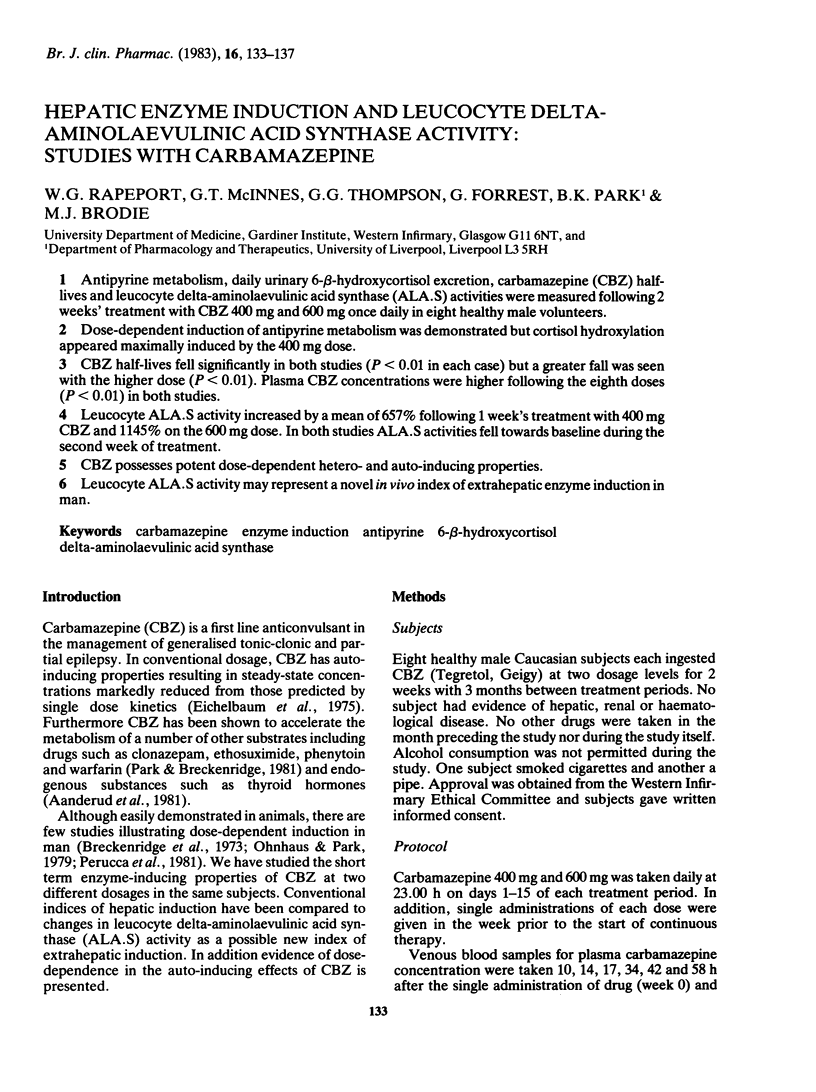
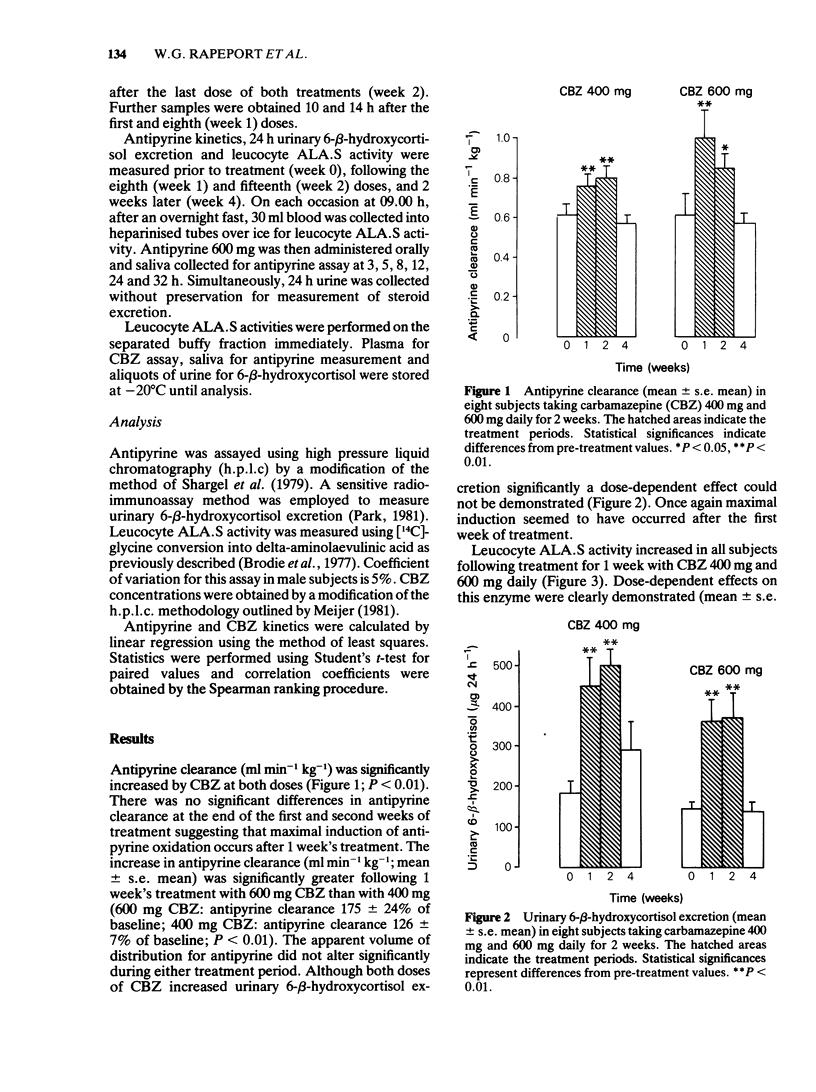
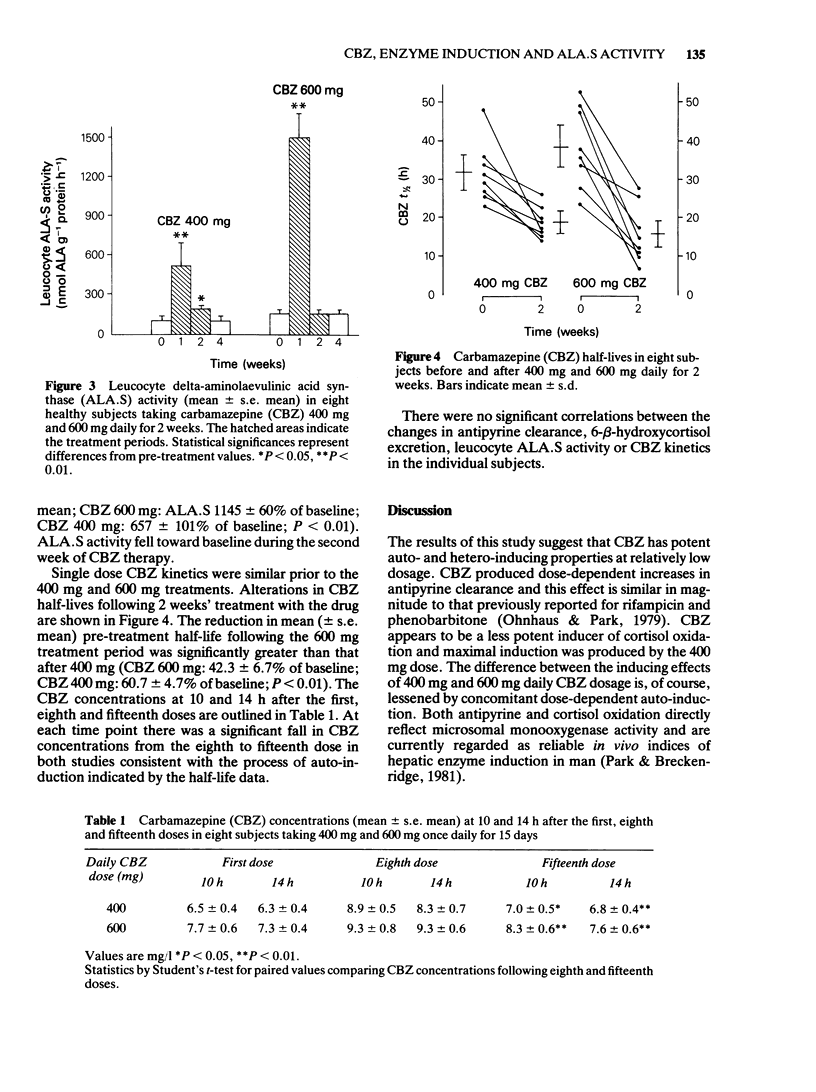
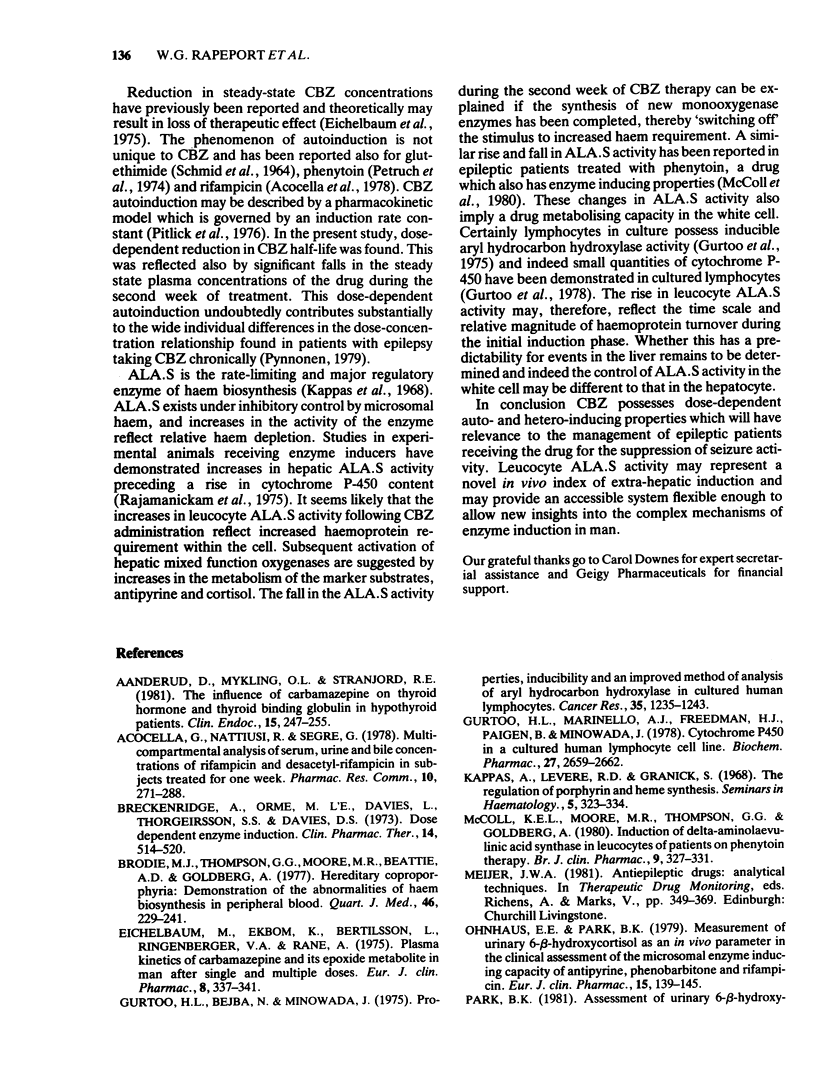
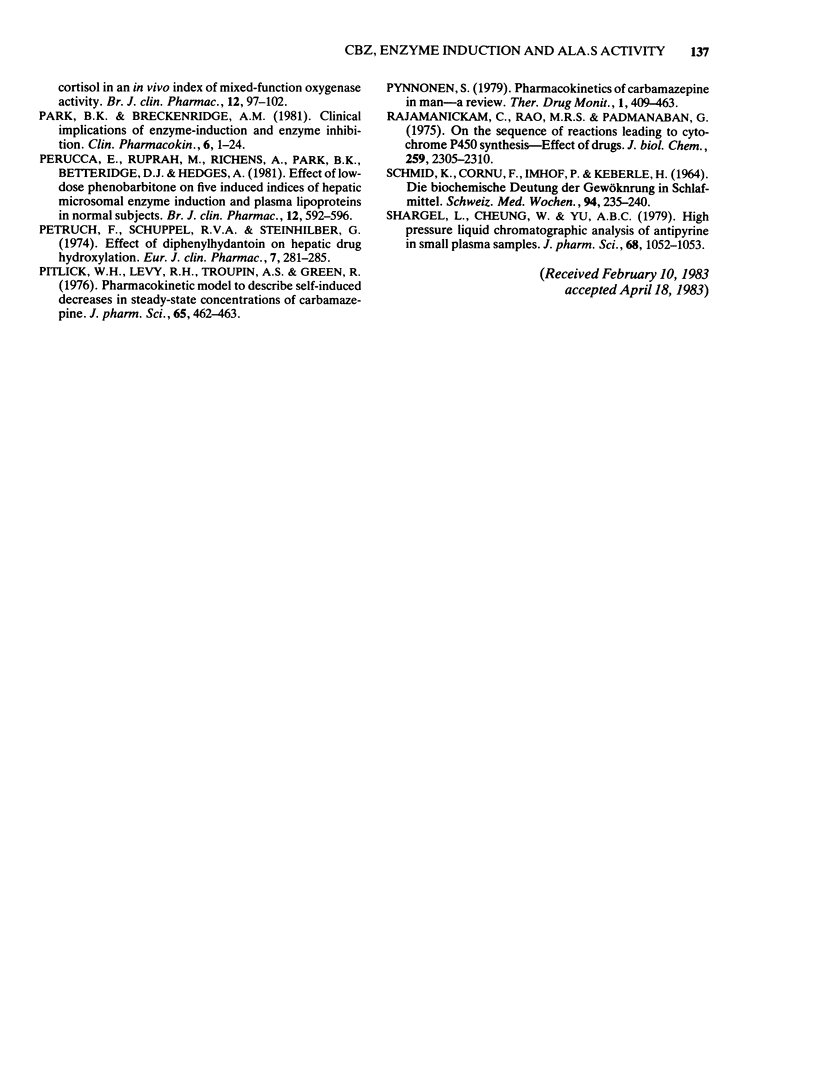
Selected References
These references are in PubMed. This may not be the complete list of references from this article.
- Acocella G., Mattiussi R., Segre G. Multicompartmental analysis of serum, urine and bile concentrations of rifampicin and desacetyl-rifampicin in subjects treated for one week. Pharmacol Res Commun. 1978 Mar;10(3):271–288. doi: 10.1016/s0031-6989(78)80021-6. [DOI] [PubMed] [Google Scholar]
- Breckenridge A., Orme M. L., Davies L., Thorgeirsson S. S., Davies D. S. Dose-dependent enzyme induction. Clin Pharmacol Ther. 1973 Jul-Aug;14(4):514–520. doi: 10.1002/cpt1973144part1514. [DOI] [PubMed] [Google Scholar]
- Brodie M. J., Thompson G. G., Moore M. R., Beattie A. D., Goldberg A. Hereditary coproporphyria. Demonstration of the abnormalities in haem biosynthesis in peripheral blood. Q J Med. 1977 Apr;46(182):229–241. [PubMed] [Google Scholar]
- Eichelbaum M., Ekbom K., Bertilsson L., Ringberger V. A., Rane A. Plasma kinetics of carbamazepine and its epoxide metabolite in man after single and multiple doses. Eur J Clin Pharmacol. 1975 Jun 13;8(5):337–341. doi: 10.1007/BF00562659. [DOI] [PubMed] [Google Scholar]
- Gurtoo H. L., Bejba N., Minowada J. Properties, inducibility, and an improved method of analysis of aryl hydrocarbon hydroxylase in cultured human lymphocytes. Cancer Res. 1975 May;35(5):1235–1243. [PubMed] [Google Scholar]
- Gurtoo H. L., Marinello A. J., Freedman H. J., Paigen B., Minowada J. Cytochrome P-450 in a cultured human lymphocyte cell line. Biochem Pharmacol. 1978;27(22):2659–2662. doi: 10.1016/0006-2952(78)90346-5. [DOI] [PubMed] [Google Scholar]
- Kappas A., Levere R. D., Granick S. The regulation of porphyrin and heme synthesis. Semin Hematol. 1968 Oct;5(4):323–334. [PubMed] [Google Scholar]
- McColl K. E., Moore M. R., Thompson G. G., Goldberg A. Induction of delta-aminolaevulinic acid synthase in leucocytes of patients on phenytoin therapy--comparison with changes in rat hepatic tissue. Br J Clin Pharmacol. 1980 Apr;9(4):327–331. doi: 10.1111/j.1365-2125.1980.tb01058.x. [DOI] [PMC free article] [PubMed] [Google Scholar]
- Ohnhaus E. E., Park B. K. Measurement of urinary 6-beta-hydroxycortisol excretion as an in vivo parameter in the clinical assessment of the microsomal enzyme-inducing capacity of antipyrine, phenobarbitone and rifampicin. Eur J Clin Pharmacol. 1979 Mar 26;15(2):139–145. doi: 10.1007/BF00609878. [DOI] [PubMed] [Google Scholar]
- Park B. K. Assessment of urinary 6 beta-hydroxycortisol as an in vivo index of mixed-function oxygenase activity. Br J Clin Pharmacol. 1981 Aug;12(2):97–102. doi: 10.1111/j.1365-2125.1981.tb01186.x. [DOI] [PMC free article] [PubMed] [Google Scholar]
- Park B. K., Breckenridge A. M. Clinical implications of enzyme induction and enzyme inhibition. Clin Pharmacokinet. 1981 Jan-Feb;6(1):1–24. doi: 10.2165/00003088-198106010-00001. [DOI] [PubMed] [Google Scholar]
- Perucca E., Ruprah M., Richens A., Park B. K., Betteridge D. J., Hedges A. M. Effect of low-dose phenobarbitone on five indirect indices of hepatic microsomal enzyme induction and plasma lipoproteins in normal subjects. Br J Clin Pharmacol. 1981 Oct;12(4):592–596. doi: 10.1111/j.1365-2125.1981.tb01274.x. [DOI] [PMC free article] [PubMed] [Google Scholar]
- Petruch F., Schüppel R. V., Steinhilber G. Effect of diphenylhydantoin on hepatic drug hydroxylation. Eur J Clin Pharmacol. 1974 Jul 26;7(4):281–285. doi: 10.1007/BF00560345. [DOI] [PubMed] [Google Scholar]
- Pitlick W. H., Levy R. H., Tropin A. S., Green J. R. Pharmacokinetic model to describe self-induced decreases in steady-state concentrations of carbamazepine. J Pharm Sci. 1976 Mar;65(3):462–463. doi: 10.1002/jps.2600650344. [DOI] [PubMed] [Google Scholar]
- Pynnönen S. Pharmacokinetics of Carbamazepine in man: a review. Ther Drug Monit. 1979;1(3):409–431. doi: 10.1097/00007691-197901030-00014. [DOI] [PubMed] [Google Scholar]
- Rajamanickam C., Rao M. R., Padmanaban G. On the sequence of reactions leading to cytochrome P-450 synthesis-effect of drugs. J Biol Chem. 1975 Mar 25;250(6):2305–2310. [PubMed] [Google Scholar]
- SCHMID K., CORNU F., IMHOF P., KEBERLE H. DIE BIOCHEMISCHE DEUTUNG DER GEWOEHNUNG AN SCHLAFMITTEL. Schweiz Med Wochenschr. 1964 Feb 15;94:235–240. [PubMed] [Google Scholar]
- Shargel L., Cheung W. M., Yu A. B. High-pressure liquid chromatographic analysis of antipyrine in small plasma samples. J Pharm Sci. 1979 Aug;68(8):1052–1054. doi: 10.1002/jps.2600680835. [DOI] [PubMed] [Google Scholar]


